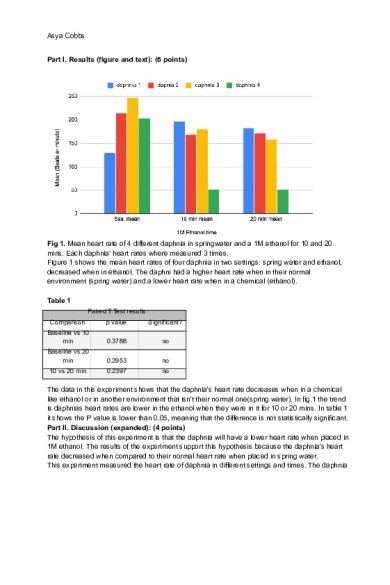Biopost lab -wk7 - Lab PDF

| Title | Biopost lab -wk7 - Lab |
|---|---|
| Course | Introductory Biology II |
| Institution | University of Delaware |
| Pages | 2 |
| File Size | 104.2 KB |
| File Type | |
| Total Downloads | 13 |
| Total Views | 175 |
Summary
Lab...
Description
Asya Cobbs Part I. Results (figure and text): (6 points)
Fig 1. Mean heart rate of 4 different daphnia in springwater and a 1M ethanol for 10 and 20 mins. Each daphnia’ heart rates where measured 3 times. Figure 1 shows the mean heart rates of four daphnia in two settings: spring water and ethanol, decreased when in ethanol. The daphni had a higher heart rate when in their normal environment (spring water) and a lower heart rate when in a chemical (ethanol). Table 1 Paired T Test results Comparison
p value
Significant?
Baseline vs 10 min
0.3788
no
Baseline vs 20 min
0.2953
no
10 vs 20 min
0.2397
no
The data in this experiment shows that the daphnia's heart rate decreases when in a chemical like ethanol or in another environment that isn't their normal one(spring water). In fig.1 the trend is daphnias heart rates are lower in the ethanol when they were in it for 10 or 20 mins. In table 1 it shows the P value is lower than 0.05, meaning that the difference is not statistically significant. Part II. Discussion (expanded): (4 points) The hypothesis of this experiment is that the daphnia will have a lower heart rate when placed in 1M ethanol. The results of the experiment support this hypothesis because the daphnia's heart rate decreased when compared to their normal heart rate when placed in spring water. This experiment measured the heart rate of daphnia in different settings and times. The daphnia
Asya Cobbs were able to live in spring water and have a normal heart rate. But when in ethanol the daphnia’s heart rate started to decrease when placed in it for 10 and 20 minutes. This test was done before and a similar effect happen, “six-minute emmusion in ethanol also significantly decreased the heart rate” (Kaas, Krishnarao, Marion, Stuckey, and Khon, 2009) Because the p value is less than 0.05 it is not significant. “You are looking for this value to be 0.05 or less for a difference to be statistically significant” (Hodson, 2014). Part III. Suggestion for future experiment with justification (2 points) Because the overall hypothesis is that the daphnia's heart rate decreases when placed in another environment other than spring water. The next experiment i would do would be to place them in another chemical other than ethanol. And maybe place them in the chemical for a different amount of time other than 10 and 20 minutes to see if time has an effect on their heart rate as well. Part IV. References (1 point) R.C. Hodson BISC208 lab manual 19th ed., 2014 Kaas, Bonnie, et al. "Effects of melatonin and ethanol on the heart rate of Daphnia magna." Impulse: the premier journal for undergraduate publications in the neurosciences (2009)....
Similar Free PDFs

Biopost lab -wk7 - Lab
- 2 Pages

Lab 2 lab sheet - lab
- 6 Pages

Astronomy Lab - lab assistance
- 25 Pages

GFP LAB - lab
- 7 Pages

Lab 7 - Ochem lab
- 9 Pages

LAB Guide - lab
- 100 Pages

Final Lab Fridge - Lab
- 1 Pages

Lab 1 Physics - Lab
- 4 Pages

LAB 5 - Lab report
- 4 Pages

Protein digestion lab - Lab
- 3 Pages

Lab Forces Motion - lab
- 2 Pages

Lab 8 - lab report
- 6 Pages

TLC Lab Lab Report
- 4 Pages

Lab 3 - Lab assignment.
- 5 Pages

Lemonade Lab - Lab report
- 4 Pages

Walking lab 1 - lab
- 4 Pages
Popular Institutions
- Tinajero National High School - Annex
- Politeknik Caltex Riau
- Yokohama City University
- SGT University
- University of Al-Qadisiyah
- Divine Word College of Vigan
- Techniek College Rotterdam
- Universidade de Santiago
- Universiti Teknologi MARA Cawangan Johor Kampus Pasir Gudang
- Poltekkes Kemenkes Yogyakarta
- Baguio City National High School
- Colegio san marcos
- preparatoria uno
- Centro de Bachillerato Tecnológico Industrial y de Servicios No. 107
- Dalian Maritime University
- Quang Trung Secondary School
- Colegio Tecnológico en Informática
- Corporación Regional de Educación Superior
- Grupo CEDVA
- Dar Al Uloom University
- Centro de Estudios Preuniversitarios de la Universidad Nacional de Ingeniería
- 上智大学
- Aakash International School, Nuna Majara
- San Felipe Neri Catholic School
- Kang Chiao International School - New Taipei City
- Misamis Occidental National High School
- Institución Educativa Escuela Normal Juan Ladrilleros
- Kolehiyo ng Pantukan
- Batanes State College
- Instituto Continental
- Sekolah Menengah Kejuruan Kesehatan Kaltara (Tarakan)
- Colegio de La Inmaculada Concepcion - Cebu